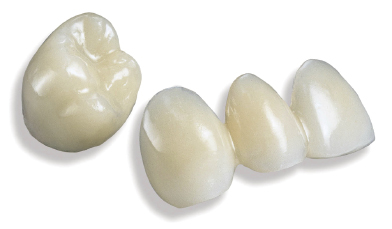36
Provisional filling materials and restorations
Figure 36.1 (a) Clinical photograph of patient’s mouth before treatment. (Courtesy of Heraeus Kulzer US.) (b) Temporized patient with Venus Temp 2 provisional restorations. (Courtesy of Heraeus Kulzer US.)

Figure 36.2 Triad® light-cured provisional restorations. (Courtesy of Dentsply International.)

Table 36.1 Average properties of temporization resins
| Acrylic resin | Bis-Acrylic composite | |
|---|---|---|
| Polymerization shrinkage (linear %) | 4.9 | 2.9 |
| Transverse strength (MPa) | 63 | 70 |
| Flexural modulus (GPa) | 1.5 | 1.7 |
Provisional (temporary) restorative materials are used for interim sealing of prepared cavities. Provisional restorations are used to maintain esthetics (in the anterior region), to ensure functionality in both anterior and posterior teeth, and to provide protection for preparations as well as close (seal) coronal access openings after endodontic therapy to prevent re-infection before final restoration delivery. The clinical requirements of these provisional materials are indicated in Box 36.1, although no material satisfies all criteria.
Stay updated, free dental videos. Join our Telegram channel

VIDEdental - Online dental courses


